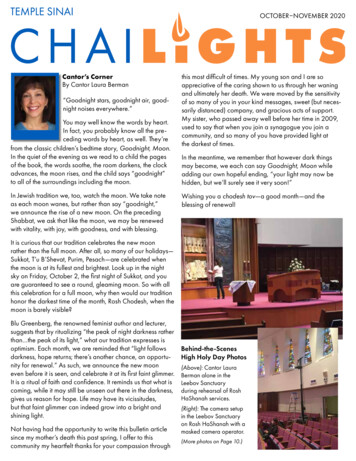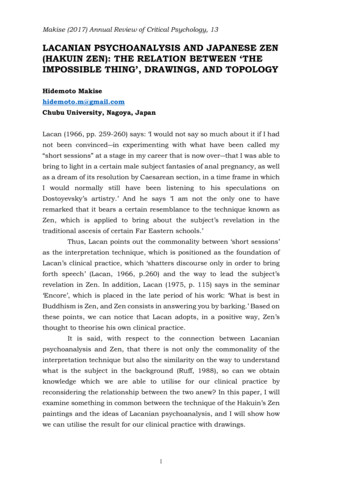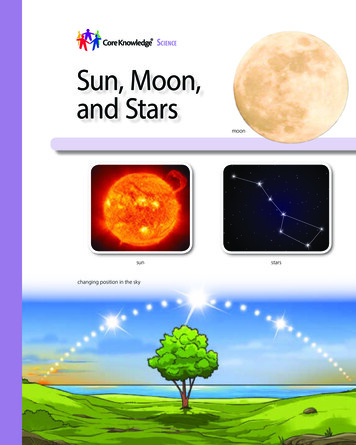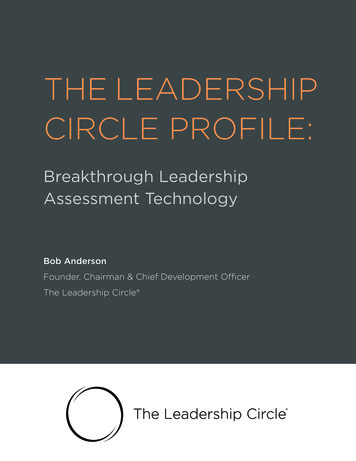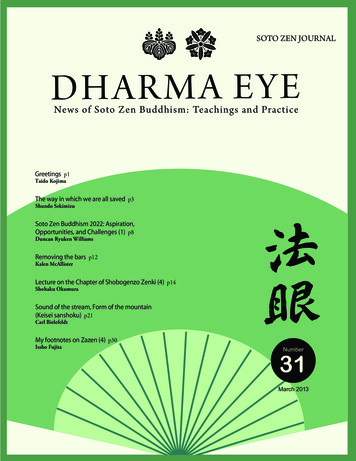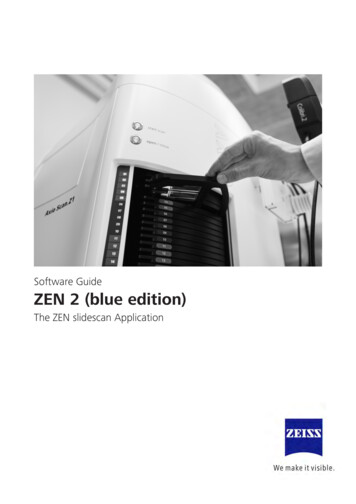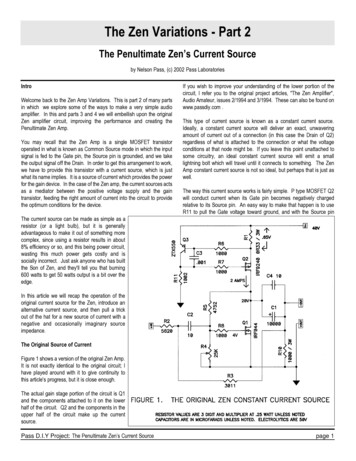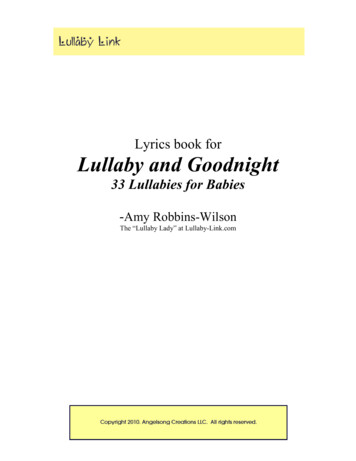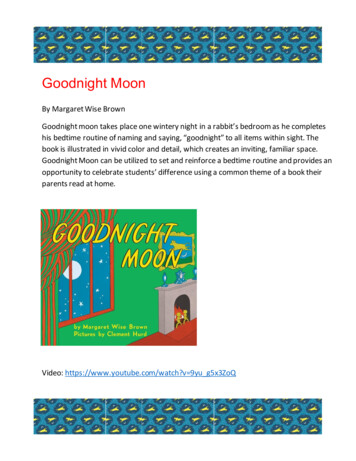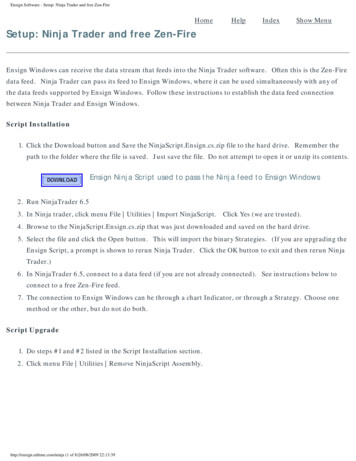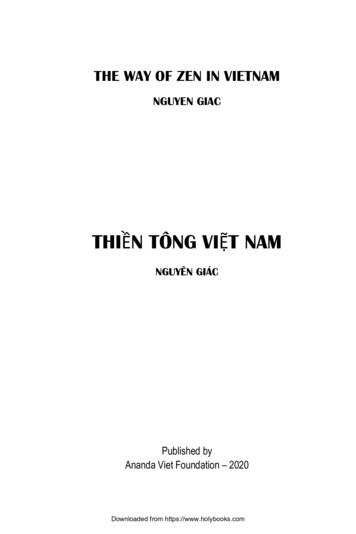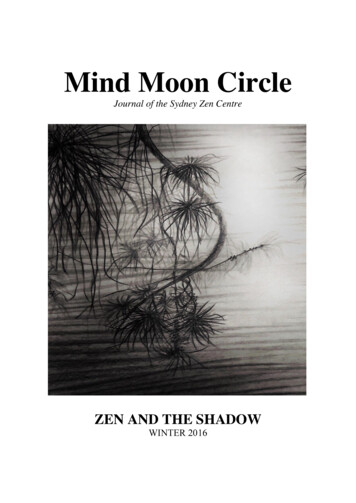
Transcription
Mind Moon CircleJournal of the Sydney Zen CentreZEN AND THE SHADOWWINTER 2016
WINTER 2016Zen and the ShadowGrandmother Hilda – Out of the ShadowsSubhana Barzaghi3The Song of the Butcher BirdsHelen Sanderson7You Can’t Get a Hold of It!Maggie Gluek8I take up the way of Not StealingBrendon Stewart10Mysterious IntimationsSally Hopkins16Zen and the Shadow Caroline Josephs17A Zen Shadow PoemPhilip Long24“Is It Enough To Meditate?”Sarah Walls25Me and My ShadowPhilip Long33Face to FaceSally Hopkins38 Cover Drawing: Untitled. Graphite on Rice Paper: Glenys Jackson.Editor: Philip Long.The next issue of Mind Moon Circle (Spring 2016) will be edited by Diana Levy. Diana will email details of thetheme and deadline for contributions in the near future. Contact Diana on diana.r.levy@gmail.com.Mind Moon Circle is published quarterly by theSydney Zen Centre, 251 Young Street Annandale, NSW 2038, Australia.On the web at www.szc.org.au - Annual subscription 282
Grandmother Hilda - Out of the shadowsReleasing the shame that bindsSubhana BarzaghiIt was a rare occasion to have afternoon tea at the Channon Tea House with mygrandmother Betty Robbins, my mother, my brother Phillip, sister Narelle and myself.Although Grandma was elderly she had bravely driven down from Brisbane to the NorthernRivers region of N.S.W. in the summer of 1984. For the five of us to be together under theone roof was something that had not happened for three decades since we were youngchildren.Grandmother Betty was a spritely woman from a good resilient Scottish stock who rarely hada sick day in her life. Sadly, grandfather died from a heart attack in his mid-fifties leavingBetty to live for another forty years alone. Betty played lawn bowls even in her eighties andmaintained her fitness with her daily walks along Queens Parade and Redcliff beach.Determined and self-reliant she continued to live in her own home until she was ninety yearsof age. She loved and collected antique grand clocks of all shapes and sizes, which werepositioned in every nook and cranny of her house. I remember as a child feeling likeminiature Alice in wonderland in her house, that I was living inside one big chiminggrandmotherly clock. She was a generous warm and friendly soul, good-natured with a downto earth humour. Even in her nineties her mind was lucid and present, she was tuned intoworldly events and the last lively conversation I had with her at 92 years of age was about thefoolishness of George W. Bush and the craziness of the Iraq war.At the Channon Tea House on a warm relaxed summer afternoon the pleasantries of anEnglish afternoon tea arrived with scones, cream, strawberry jam and pots of Darjeeling tea.After the normal greetings and catch-up, suddenly out of nowhere from the far recesses of mymind, like an indigestible seed that just had to be vomited out, I suddenly blurted out over thechina cups, “What happened to Grandma? . Dad’s mother I mean?” This question shockedand dumbfounded everyone at the table, including me. It was like the bad fairy had comealong and tipped the teapot upside down spilling and staining the white tablecloth withshadows from the past.Stunned expressions were cast across my brother and sister’s faces, as if to say have you gonea bit mad? There was no preamble or entree. It seemed like a crazy question to ask thatmade absolutely no sense given that Grandma Betty was sitting opposite me and she was theonly grandmother that we had ever known.However, in that moment, I realised that she was my father’s stepmother and not hisbiological mother and therefore Betty was not our biological grandmother. I cannot explainhow this realisation suddenly dawned on me. There was no information or story that I couldconsciously recall where I had been told that Betty was our step-grandmother. I do have apsychic intuitive ability at times and have come to trust that over the years.There was a long awkward silence before Betty spoke. “Peter’s (my father) mother ‘Hilda’died when he was a teenager,” admitted Betty.“So,” I asked curiously, “What happened to her, how did she die?”Betty’s voice faltered betraying the awkwardness of the situation. “She took a lot of pills,”she stammered.3
My antenna was now on hyper alert, sensing that we had just headed into unknown andperhaps forbidden territory. The hound in me picked up the scent, “What do you mean, shetook a lot of pills? How many pills?” I kept pressing.“A lot of pills,” Betty stressed, her brow furrowing with concern.Again there was a long pause and an old familial weighty silence hushed the table. It waslike that strange eerier silence that comes after the first earthquake shock wave and everyoneis poised, alert, bracing themselves for the after shocks.“Do you mean to say, she took an overdose of pills accidently or did she commit suicide,” Iasked, my voice trailing into a whisper.Betty silently nodded; she could not actually utter the word ‘suicide’. Shame fell like afrozen blanket of shock over the table.It somehow took two generations to pass by before an unconscious splinter pierced throughinto my internalised genogram, into a grand-daughter’s mind on an innocent summers dayover an English afternoon tea party - to possibly think and ask the unthinkable, to say theunnameable. Emotion at the table was poised, held in suspension. Phillip and Narelle satthere stunned their mouths tightly shut. Mum visibly upset now uttered under her breath thatPeter had told her the story of his mother’s death just after they were newly weds. “Peter,forbade me to tell you,” she said, tears welling behind her eyes.Years later I discovered that my biological Grandmother Hilda had died at 42 years of age.She had been buried twice, the first time literally and the second time concealed out of mind,silenced to the shadows and frozen out of our minds and hearts. She did not exist in my minduntil now. It was a dark, shameful family secret but now the shadow was present at the table,like an unwelcome guest.Hilda was born in the early 1900’s in a white Anglo-Saxton Christian conservative culturewhich viewed suicide as a cardinal sin and hence the family member was often not evengiven a proper burial. The priest could refuse to perform the funeral rites. It brought shameand disgrace to any family. That story had now been prised open and her life and pain hadopened up an array of questions that flooded through my mind. Was it an accident or not?Who was she? Was she depressed? Who found her? Why did she do it? Where was sheburied or cremated? Were her sons who were young boys at the time allowed to attend herfuneral? While these questions rattled me, I was still, however, so shocked that I could notactually ask Betty any further questions. All those bits of information like an archaeologicaldig gradually came to the surface years later.It was enough for now. I sipped at my cold tea and finished my scone leaving an indigestiblelump in my stomach. Betty had graciously told us the painful truth, the shameful trance wasbroken and I was so grateful for her honesty. That afternoon, there was a new addition to thefamily reunion. Our tea party had grown and Hilda’s ghost was the unexpected guest. Isilently drank tea to the Grandmother that I never knew.My brother was quick to grasp the implications of this story and we later puzzled over itsrepercussions. I went home and bawled my eyes out. I cried for the grandmother that I hadand the one I never knew. A spectre had arisen out of the dark reaches of the past; she hadbeen buried but now not forgotten.A whole lot of missing pieces from the family jigsaw puzzle had finally fallen into place. Forthe first time, I felt a quivering of compassion for my father. I was aware that Dad had never4
bonded with Betty and now I had an inkling why. The sudden death of his mother when hewas a young boy edging into adolescence would have been a terrible loss for him and hisyounger brother. His relationship with his mother was obviously bound up with love andthen a curtain of shame. It was forbidden territory so terrible that one could not even mentionher name. I began to understand the relationship between his abrupt loss of his mother andhis abrupt departure from our family and the severing of connection with his own children. Isuspect that Dad probably shut down after Hilda’s sudden death, closed his heart as a youngman. There was probably no grief counselling or emotional support available at that time.Men ‘soldiered on with a stiff upper lip’. It started to make sense why my father was and stillis so cut off from his emotions, his amputated affect, his introverted self-absorbed stance inlife, his inability to communicate and reach out and take an interest in his own children’saffairs. His frozen pain and therefore frozen love.I pondered on how to reconcile this story and turned to my Zen practice. The koan that spoketo me and offered another dimension of healing to the family shadow was ‘Save a Ghost.’This koan is part of the Miscellaneous Koan Collection and requires a deep understandingand realisation that dissolves the dualistic sense of separation between oneself and a ghost inthis particular case. ‘Save a Ghost’ addresses an underlying broader Bodhisattva quest andquestion; how do we save all beings, how do we save anyone or anything? To save oneselfand all beings is to wake up from the illusion of separation and to realise our true intimacywith all beings.I became curious about the character dimension to this koan, which brought me face to facewith the ghost. The ‘ghost’ is a metaphor and like all metaphors offers fluid interpretations.The ‘ghost’ in this koan is not referring to a childhood cartoon caricature of a ghost but hintsat the ‘hungry ghost’ referred to in our Zen meal sutras. The ‘hungry ghost’ is an analogyfor the restless, clinging, never-ending, wanting mind, never satisfied, which is marked as oneof the root causes of suffering. The ‘ghost’ can stand in for our shadow, the disowned, theneglected, the fearful parts or exiled parts of our own psyche or it could be the shadow in thefamily system or our wider cultural legacy. To ‘save a ghost’ requires a fearless presence, anhonesty and willingness to meet and know that which resides just on the outskirts ofconsciousness, to turn towards it and be intimate with all that it entails.I sought to apply the understanding and wisdom of this koan to help me address and heal theshame of our family secret. The circumstances of Grandmother Hilda’s death will never befully known, whether it was an accidental overdose or her attempt to self-medicate againstmyocarditis (a viral infection to the heart that became fatal) or suicide – which resulted insudden cardiac arrest from the overdose. However one turns the dice the result was that herdeath was cast in shadow.What became important to me was to heal the family shame that binds us and to releaseHilda’s spirit and give her a seat at the family table. Shame can no longer continue to hauntus when it is brought out in the open and shared. For what was buried and lost to theshadows when resurrected into the light creates the possibility of healing and liberation.With these few morsels of information I felt an urge to write a letter to my long lostgrandmother.Dear Grandmother Hilda,Welcome, there is a seat at our family table; I am keeping it warm for you. You are no longerbanished; the shame has been dispelled. No doubt you had dreams for a life beyond the5
mundane shores of domesticity. I see the heart that failed you was also a heart full of lovethat flowed over and produced two young boys, who grew and fathered children in their turnthat you would never know. You lived through the ravages of the Second World War and Ican only barely imagine the scars of those dark times. I sense you struggled with your owndark nights of vulnerability and fear as we all do, surfing the 10,000 joys and sorrows of alife to the best of our ability. Whatever pain you suffered from myocarditis, whether yourheart gave way or it all became too much for you to bear, I do not blame you, I understandthat now. Perhaps it was an accident and you didn’t intend to die when you did. Whateverthe secret burden that shrouded your death, the veil is lifted now. You have become anotherhole in the family flute from the sweet music of forgiveness. You did not know you were anangel in disguise. I see you now and you are beautiful, you are free, unburdened, you havewings. The empty chair is filled with your scent of light, your presences graces our table ofbelonging once more. Would you like to have some tea and scones?All that frightens me I turn into holy incense ash and offer it up to the altar of the heart thatdissolves all boundaries. A much loved Sufi poet from Persia, Muhammad Hafizencapsulates the sentiments of forgiveness in his poem, My Sweet, Crushed Angel.You have not danced so badly, my dear,Trying to hold hands with the beautiful one.Our partner is notoriously difficult to follow,And even his best musicians are not always easy to hear.You have not danced so badly, my dear,You have actually waltzed with tremendous style,O my sweet, O my sweet crushed angel.References:I heard God Laughing – Renderings of Hafiz, 1996, translated by Daniel Ladinsky,Sufism Reoriented, Ca. USA.‘Save a Ghost’ – Introductory Miscellaneous Koan Collection – Diamond SanghaPublications.6
Woman With WingsDrawing, gold and silver oil sticks: SubhanaThe Song of the Butcher BirdsHelen SandersonEarly in the still grey airButcher birds sang an early morning prayerButcher bird 1: Joy to the worldButcher bird 2: Here comes the dayTogether:Life is for singingWe warble and pray.7
You Can’t Get a Hold of It!Maggie GluekAh, shadow, that old trickster. That original shape-shifter. Now short and fat, now tall andskinny, like Fun House mirrors. Now a grand giant, and now an imp hiding. Now you see it,now you don’t. Shadow plays in the illuminated world, and dances too. Sometimes it issummoned as entertainment there’s a fox, and, there—oh, look out, rabbit! But alwayswhen it appears, whether one is conscious of this or not, it is a reminder of the fluidity ofexistence, a mysterious two-dimensional upaya.All things are under the law of change. They are a dream, a phantom, a bubble, or a shadow.The beautiful metaphors of the Diamond Sutra point to the fact that no form endures as asubstantial or separate reality. Thus the shadow of this apparently solid body of mine—it’sme!!—reveals not-me. One cannot be separated from the other. Self-nature is no-nature afterall. But isn’t there a lifetime of work in effectively embodying this realisation of not-self? Inthe language of the Diamond Sutra, you must realise this too: a body is not a body; thereforeit is called a body. The next step is again and again returning to the market-place, to theordinary, to living your life generously. Don’t chase representations, don’t get tangled inideas. Hi there!In the language of psychology, the construction called “shadow” also points to what isperceived as “not me.” Not in this case to something universal but to a particularunacknowledged part of one’s personality, lying in shadow, unseen and indeed disowned.Paradoxically it can be seen in individuals who happen to embody the quality of characteryou deny in yourself. The clue that you are meeting such an individual is that the encountercreates psychic disturbance for you. Heat! Once recognized, then you just might reclaim andaccept this quality in yourself.A personal example: Having been schooled or having somehow decided to hold back ratherthan to risk putting myself forward I have tended through my life to be timid. And easilyintimidated and put off by strongly competitive people. I’m not like THAT! An aggressivegame player (my husband at Anagrams, say) angers and unsettles me. I am afraid of failure,but the fact is, I want to win! Though in school I competed intensely with myself, andtherefore did well, opting out of competition may have closed many doors. While no doubtother doors have opened, I think it’s important not to be afraid of your own power.I wonder whether fear is not the real shadow in the psyche, for everyone. Whatever you don’twant to face becomes stronger and scarier as it remains unexamined over time, as you clingto a misperception, an imagined story. Like the bogeyman under the bed whom you don’twant to see. The more you refuse to look, the more and more real “he” becomes. There’s anold Chinese story about a man who is offered a cup of wine by his friend. He looks in the cupand sees a snake but nevertheless, albeit with horror, he drinks the wine so as not to offendhis friend. Thereupon he becomes extremely ill, convinced the snake has poisoned him. Thematter is finally resolved when the “snake” is revealed to be the shadow of his friend’s bowwhich hangs on the wall, reflected in the cup. Learning this, the man is no longer deceivedand he instantly becomes well again.True healing, psychological or spiritual, comes with seeing clearly, seeing through falseperceptions and assumptions. And, it seems to me, it is always about wholeness, integratingthe other side. Light is shadow’s most intimate self!8
Zen training begins with taking the decision to meditate. I did so with apprehension because Iwas sure that, if I looked “inside”, I would find my personal demons, those dark dimensions Ihad been avoiding my whole life. Guess what? You know. No bogeymen. Just hindrances inthe mind, as the Heart Sutra puts it, thoughts and feelings that appear and dissolve likeeverything else. Not that fear doesn’t still arise with the unfamiliar, the unknown, theuncontrollable. At an extreme there is the valley of the shadow of death, a powerful conditionto pass through. But practice lends perspective.I am heartened in remembering Mahakala, wrathful Tantric deity, protector of the Dharmaand manifestation of Avalokitesvara. Black and terrifying in aspect, he tramples delusion andas the Lord of Time subsumes the universe. Hello, darkness, my old friend! Maybe it doesn’tfeel that friendly at 3 am when the world is in shadow and the mind subsumed in chaoticthoughts. Who said anything about perspective? What is it? To pinch a line from case 86 ofthe Blue Cliff Record, and out of context even—The darkness is dark, dark. But really, that’sall there is to it. The darkness is dark, dark. Just so.UntitledPhoto: Caroline Josephs9
I take up the way of Not StealingBrendon StewartSelf nature is subtle and mysterious. In the realm of the unattainable Dharma, not havingthoughts of gaining is called the Precept of Not Stealing.Leaving again for the front at 3.30pm.Arrived at 12 mile airdrome by truck& marched to commando’s camp at Laloki,arriving after dark.Bedded down for the night,very tired.Saturday, re-equippedLeft 4.30pm & marched to Goldie River(Harold Stewart)A war storyWe might be inclined to equate the second precept with "thou shalt not steal" as in the TenCommandments. But the second precept is not a commandment and is not understood in thissame way. A more literal translation from the early Pali texts is "I undertake the precept torefrain from taking that which is not given."To refrain from taking that which is not given is more than just respecting other people'sproperty. This second precept by way of paradox can also be an incentive to practicegenerosity. Stealing may be an attempt to relieve genuine distress and hardship. In this case acompassionate response to what seems like a misdemeanor is called for. And yes, it can berelatively easy to find the compassion when attempting to adjudicate in some circumstancethat may only involve material things, food stolen from a supermarket by a hungry person, orthe waywardness of a young person caught in the heat of showing off. What is at stake whenit comes to lands taken without being freely given or cultural treasures plundered andappropriated?I fell unwittingly into my Zen practice not long after coming home from living for half adozen years in the United Kingdom. There is a strong resonance for me with my AngloAustralian culture-scape. My cultural reach embraces the landscapes and histories that shapeand embrace this complexity.John Cooper, my yoga teacher at the time introduced me to Zen. His friend Robert AitkenRoshi and his wife Anne were on their first visit to Sydney in 1979. A little time beforehandJohn offered his yoga students the chance to experience Zazen one Saturday afternoon at hishome in Boronia Park.Robert Aitken came to Zen while spending time as a civilian prisoner in a Japaneseinternment camp near to the city of Kobe during the Second World War. To wile away thedays, weeks and years he took up the study of haiku.And then 10
One evening a guard came into my room, quite drunk, waving a book in the air andsaying in English, “This book, my English teacher . . .” He had been a student of R.H.Blyth at Kanazawa, and the book, Zen in English Literature and Oriental Classics, hadjust recently been published. I was in bed but jumped up to look at the book and wasimmediately fascinated. I persuaded the guard to lend it to me, and weeks later hebought another copy for me so that he could have his own copy back.I suppose I read the book ten or eleven times straight through. As soon as I finished it, Iwould start it again. I had it almost memorized and could turn immediately to anyparticular passage. It was my “first book,” the way Walden was the “first book” forsome of my friends, the way The Kingdom of God Is Within You was the “first book”for Gandhi. Now when I look at it, even the type looks different, far smaller in size, andthe references to Zen seem less profound. But it set my life on the course I stillmaintain, and I trace my orientation to culture - to literature, rhetoric, art, and music - tothat single book.It wasn’t until May 1944 when the camps around Kobe were combined and housedtogether in a former reform school: Rinkangaku, in Futatabi Park on the hills above Kobe. Itwas here that Robert Aitken was able to meet Mr. Blyth.After a time we established the intimate relationship we were to maintain until his deathin 1964, and which we still maintain today, though he has been dead a long time.I sometime wonder whether Robert Aitken ever thought about that gruff, drunk guard andhis part in how that single book coloured his appreciation of literature, rhetoric, art, andmusic. I never did sesshin with Aitken Roshi. I was once however his driver, picking Anneand him up from the airport on one of their visits to Sydney. He wasn’t in the least bitinterested in my recently purchased old Mercedes 220 SE; I on the other side of thisawkwardly silent exchange was quite besotted by the car.So too was John Tarrant Roshi, a car buff and one time favourite son in the DiamondSangha until falling out over the Dharma and Sangha relations. I attended a number ofsesshins with John which I enjoyed. I wish I’d got to know him better. He liked theMercedes:Tuning the Mercedes goes like this:After I have despaired three timesAnd three times cursed my poverty, my impracticalityAnd the sorrow in the bodyAs three useless things,After I have run propane through the carb,I build the invisible mandalaUsing a screwdriver, strobe and tachometer.The huge, restless engine grows docileAt a thousand rpm. This is alchemy:Inert and lifeless matterRedeemed because it is loved,It is mended in a long, careful workThat goes beyond itself becauseIt never turns out quite how I intended. (John Tarrant)11
A few years before the end of last century Kerry and I together with our two youngestsons, Patrick and Jesse, visited Aitken Roshi at his home on the Big Island of Hawaii. Hewas by now quite frail and in need of constant help. Despite this he was a genial host andwe stayed for lunch and then chatted about sangha matters and how it was that he heldgreat hopes for Dharma practice in Sydney. Over the afternoon we walked the peculiarlybeautiful, shiny black volcanic platform that was his front garden stretching all the way tothe Pacific waves, which collided ceaselessly onto slow moving molten larva. RobertAitken lived on the very edge of the transient earth.The Manchurian incident.It claws the ground with crooked roots. It flails Over some years I had met up with a Japanese colleague at different internationalconference venues; we both had a professional interest in Analytical Psychology, particularlythat aspect sometimes called Depth Psychology. Megumi Yama (a mother and professor inthe faculty of Human and Cultural Studies, Kyoto Gakuen University) and her husbandHerosi invited Kerry and I to spend a day together with them exploring Kyoto and laterdinner. Megumi has written quite extensively on the Manchurian experience for the Japanese.In an extensive article The Artist’s experience of Formative Work. Japanese painter YasuoKazuki and his Siberian Series she discusses how in the creative process that Kazuki engagedwith, he sank deep into an inner world out of which the artwork emerged. Kazuki was draftedfor military service in 1943 and was soon transferred to Manchuria. In 1945, after the defeatof the Japanese armies he was transported by the Russian military to Siberia to serve in alabour camp for two more years. He began painting on his return home to Japan.Megumi, Kerry, Herosi and I spend a long day climbing the many stairs that lead toTenryu-ji temple, the Temple of the Heavenly Dragon built 1339. Here legend has it Zenmaster Muso Soseki was the temple’s founding abbot. Tenryu-ji temple occupies the sitewhere the earlier Danrin-ji temple built in the ninth century once stood and then burnt downas per usual! This sacred site nonetheless is supposed to be where the first Zen temple inJapan was established.The wall in front to left and right,Leads to the upper parapet of stone,From which old cherry-trees that alternateWith maples on its narrow ledge have grown:Their leafage scant and eaten into lace,Where insects or the weather left their trace.Climbing this second stairway, I am broughtTo level ground again, the entrance court;And standing on its stone brink, look belowOn rustic stalls and restaurants that lineThe leafy tunnel, while their darkened rowBaffles a sunburst, golden in decline.(Harold Stewart)I asked Megumi whether she thought herself a Buddhist. “Yes”, she said with a sort ofreservation. “As a baby I was blessed with my family in our nearby Shinto shrine, Herosi and12
I were married there too, when I die I’ll be buried from a Buddhist temple. We Japanesedon’t think of ourselves denominationally, being something like a Buddhist a Shinto orChristian is a European way of thinking”.Over a delicious dinner we talked about our experiences growing up at different ends ofthe Pacific. Both Megumi and Herosi’s grandfathers served in the Japanese military and bothwere stationed in Manchuria. This seems to have meant, according to Megumi that they werenot active in the Second World War but rather caught in attending to an internal nationalsecurity skirmish. To this end and to our surprise we learn that the major concentration of theJapanese Imperial armed forces was stationed in both Manchuria and Korea. This mightexplain one of my father’s war diary entries:Saturday: Out on fighting patrol near Eilogo. Big rubber plantation. Had swim inEilogo river. No Japs.Emperor Hirohito ascended the Chrysanthemum throne on Christmas day, 1926. TheJapanese military and political hierarchy encouraged the deep animist beliefs of Shintotowards a full-blooded form of Emperor worship. Hirohito assumed the status of a God with acorresponding blind obedience in the Japanese people.An interesting historical aside is that General MacArthur, his military staff and advisors‘employed’ R.H. Blyth to help draft certain surrender documents the emperor wouldeventually sign, whereby acknowledging himself as a mere mortal and asking the people ofJapan to recognise him as such.We knew almost nothing of Manchuria, and it wasn’t until getting back to Sydney that Ifound out where indeed Manchuria is. Manchuria in East Asia can either refer to a region13
entirely within China or a larger region today divided between Northeast China and theRussian Far East. The Russian part is known as Outer Manchuria, the Chinese region is InnerManchuria.Japan replaced Russian influence in the southern half of Inner Manchuria as a result of theRusso-Japanese War, 1904–1905. The outcome here was somewhat the same as to how theBritish and Dutch East India Companies economically occupied India and Indonesia and thenexpected their respective governments to supply a military and police force. From 1911 to1931 Manchuria, nominally part of the Republic of China, was in practice controlled by theJapanese military. And then in 1932 Japan annexed Manchuria.Over those early twentieth century years many Japanese people emigrated, mostvoluntarily, into Manchuria and south into Korea, which was also under Japanese rule andinfluence. This was the topic of our conversation over dinner. Herosi and Megumi are bothuniversity academics and practicing psychologists and both recognize that the Manchurianepisode in Japanese history is contentious, especially as Herosi said, if you look at it from theChinese and Korean points of view. This said, they both contended that the annexation ofManchuria in 1932 was not an invasion, rather like our own choice of the word ‘settlement’when it comes to modern Australia; this was a legitimate settlement of a region already veryJapanese. Indeed, the annexation was intended to bring modern prosperity to Manchuria aswell as Japan.The confluence in Manchuria of the Russian, Chinese and Japanese militaries and theirnational ambitions was bloody and violent, and like all battlefields there can be reasons torevisit, reinvent and review on the part of survivors. Murakami in his novel The Wind-up BirdChronicle has Lieutenant Mami
Releasing the shame that binds Subhana Barzaghi It was a rare occasion to have afternoon tea at the Channon Tea House with my grandmother Betty Robbins, my mother, my brother Phillip, sister Narelle and myself. Although Grandma was elderly she had bravely driven down from Brisbane to th
